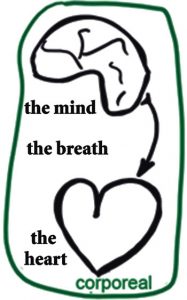A School for Prayer (21)
Mind-in-the-heart Prayer
By Fr Craig Larkin SM, 1943 - 2015
Hesychastic Prayer in the Eastern Church (2)
A spirituality of the ‘heart’ in Christian tradition
As far back as the time of the Desert Fathers, the question was raised: “Where does prayer take place? In the mind? In the heart? Or somewhere else?”
Evagrius of Pontus tended to see the ‘place’ of prayer as in the mind (the nous).
Macarius of Egypt tended to see the ‘place’ of prayer as in the heart.
Diadochus of Photike tended to see prayer as an exercise of ‘the mind in the heart’.
The Eastern tradition makes a distinction between three principal forms of prayer:
* Prayer of the lips (vocal prayer)
* Prayer of the intellect (mental prayer)
* Prayer of the mind-in-the-heart
(prayer of the heart)
The form of prayer known as mind-in-the-heart prayer came to be known as ‘hesychastic’ prayer.
Hesychastic prayer
‘Hesychia’ in Greek means peace or stillness, tranquility, freedom from disturbance and from the dominance of the passions, particularly anger, sensuality and greed.
A hesychast was a person who struggled to find this peace and inner freedom – apathaeia – and to make it the seed-bed of prayer.
The Eastern tradition draws a distinction between four types of hesychia:
1. Hesychia which comes from being alone and in solitude;
2. Hesychia which comes from resisting the compulsions of life (‘Stay in your cell!’);
3. Hesychia which means ‘returning to oneself’ (‘Watch yourself!’);
4. Hesychia which means standing still in the presence of the Lord, with the mind in the heart.
The hesychast is not someone who has embarked on an outward journey to the desert or to some isolated place, but someone who has taken up the journey inwards into his own heart. The hesychast is one who has ‘returned to himself’ as was said of the Prodigal Son.
Three elements at play in prayer
The Eastern Christian tradition presents a way of bringing the mind into the heart through some physical exercises associated with praying – especially through breathing and posture.
The tradition of the East stresses that there are three elements at play in prayer:
* the mind
* the heart
* the breath
While prayer might begin in the mind, it should descend to ‘the place of the heart’ and remain there.
Once it is there, in the place of the heart, it will remain there, and will connect itself with the beating of the heart, so that in time – after much ascetical struggle – the prayer repeats itself through the rhythmic beating of the heart.
What connects the mind with the heart is the breath. While this seems strange physiologically, it ‘works’.
How does one join the mind and the heart in prayer?
1. Find a place where you are alone.
2. Quietly but firmly shut all thoughts from your mind.
3. Attend to your breathing: make it rhythmical and slow. This takes a lot of effort; don’t hurry through this exercise.
4. Find ‘the place of the heart’ and imagine that you can feel it beating, becoming aware of the rhythm and speed of your heart-beat.
5. Slow down the beating of your heart, trying to use your rhythmical breathing to slow it down.
6. With the mind empty, put a word or phrase into your mind. Try using simply the word ‘Jesus’.
7. Send the word ‘Jesus’ from the mind down to the heart, placing it ‘on the breath’, and sending it down to the ‘place of the heart’ as you breathe out.
8. Once you can imagine it on the ‘place of the heart’, let it rest there, and feel it resting there.
9. When any of these three elements – mind, breath, heart – are not functioning as they should, go back and begin the process again.
10. With the word or phrase ‘resting on the place of the heart’, remain at peace, and let the prayer pray itself.
Then you will understand the meaning of Psalm 15:7 –
I will bless the Lord who gives me counsel
Who even at night directs my heart;
And so, my heart rejoices, my soul is glad,
even my body shall rest in safety.


 Entries(RSS)
Entries(RSS)